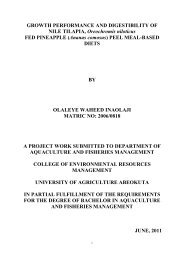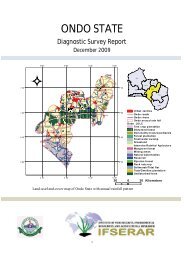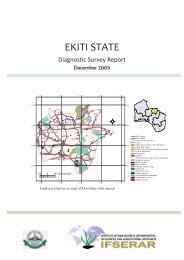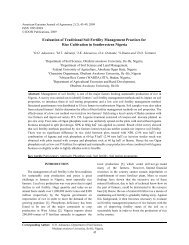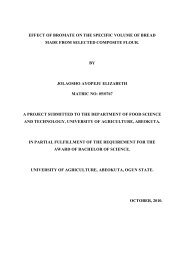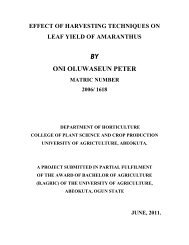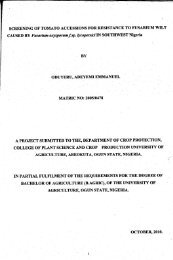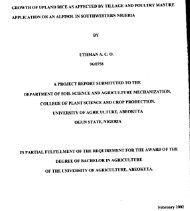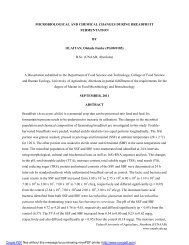presence of aflatoxins in smoked-dried fish sold in abeokuta, ogun ...
presence of aflatoxins in smoked-dried fish sold in abeokuta, ogun ...
presence of aflatoxins in smoked-dried fish sold in abeokuta, ogun ...
You also want an ePaper? Increase the reach of your titles
YUMPU automatically turns print PDFs into web optimized ePapers that Google loves.
The pr<strong>in</strong>cipal target organ for <strong>aflatox<strong>in</strong>s</strong> is the liver. After the <strong>in</strong>vasion <strong>of</strong> <strong>aflatox<strong>in</strong>s</strong> <strong>in</strong>to the<br />
liver, lipids <strong>in</strong>filtrate hepatocytes and leads to necrosis or liver cell death. The ma<strong>in</strong> reason for<br />
this is that aflatox<strong>in</strong> metabolites react negatively with different cell prote<strong>in</strong>s, which leads to<br />
<strong>in</strong>hibition <strong>of</strong> carbohydrate and lipid metabolism and prote<strong>in</strong> synthesis. In correlation with the<br />
decrease <strong>in</strong> liver function, there is a derangement <strong>of</strong> the blood clott<strong>in</strong>g mechanism, icterus<br />
(jaundice), and a decrease <strong>in</strong> essential serum prote<strong>in</strong>s synthesized by the liver. Other general<br />
signs <strong>of</strong> aflatoxicosis are edema <strong>of</strong> the lower extremities, abdom<strong>in</strong>al pa<strong>in</strong>, and vomit<strong>in</strong>g.<br />
1.1.5 Acute toxicity<br />
ICRI (2000) also acute toxicity is less likely than chronic toxicity. The pr<strong>in</strong>cipal target organ for<br />
<strong>aflatox<strong>in</strong>s</strong> is the liver. After the <strong>in</strong>vasion <strong>of</strong> <strong>aflatox<strong>in</strong>s</strong> <strong>in</strong>to the liver, lipids <strong>in</strong>filtrate hepatocytes<br />
and leads to necrosis or liver cell death. The ma<strong>in</strong> reason for this is that aflatox<strong>in</strong> metabolites<br />
react negatively with different cell prote<strong>in</strong>s, which leads to <strong>in</strong>hibition <strong>of</strong> carbohydrate and lipid<br />
metabolism and prote<strong>in</strong> synthesis. In correlation with the decrease <strong>in</strong> liver function, there is a<br />
derangement <strong>of</strong> the blood clott<strong>in</strong>g mechanism, icterus (jaundice), and a decrease <strong>in</strong> essential<br />
serum prote<strong>in</strong>s synthesized by the liver. Other general signs <strong>of</strong> aflatoxicosis are edema <strong>of</strong> the<br />
lower extremities, abdom<strong>in</strong>al pa<strong>in</strong>, and vomit<strong>in</strong>g.<br />
1.1.6 Chronic Toxicity<br />
Animals which consume sub-lethal quantities <strong>of</strong> aflatox<strong>in</strong> for several days or weeks develop a<br />
sub acute toxicity syndrome which commonly <strong>in</strong>cludes moderate to severe liver damage. Even<br />
with low levels <strong>of</strong> <strong>aflatox<strong>in</strong>s</strong> <strong>in</strong> the diet, there will be a decrease <strong>in</strong> growth rate, lowered milk or<br />
egg production, and immunosuppression. There is some observed carc<strong>in</strong>ogenicity, ma<strong>in</strong>ly related<br />
to aflatox<strong>in</strong> B1. Liver damage is apparent due to the yellow color that is characteristic <strong>of</strong><br />
jaundice, and the gall bladder will become swollen. Immunosuppression is due to the reactivity<br />
<strong>of</strong> <strong>aflatox<strong>in</strong>s</strong> with T-cells, decrease <strong>in</strong> Vitam<strong>in</strong> K activities, and a decrease <strong>in</strong> phagocytic activity<br />
<strong>in</strong> macrophages (ICRI, 2000).<br />
7



